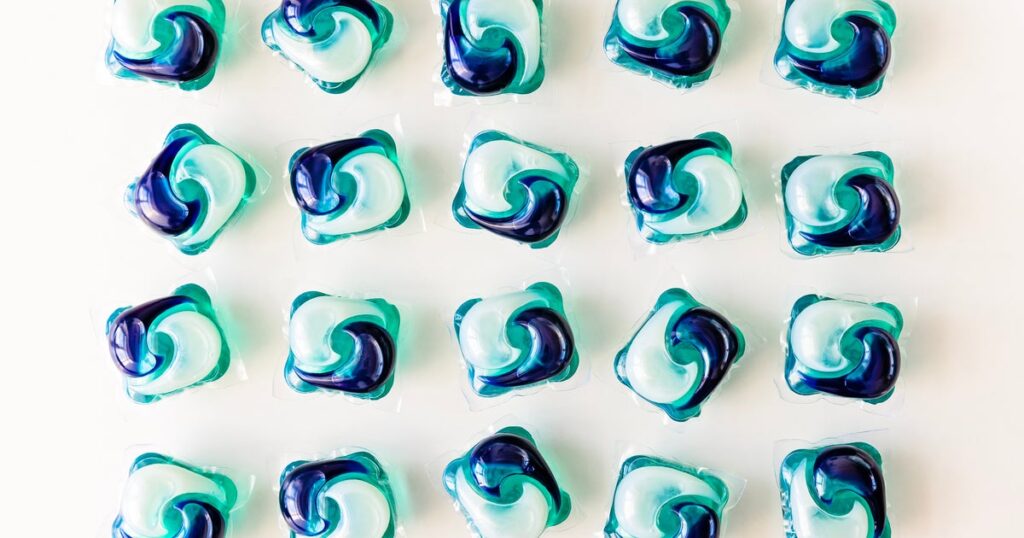If you look on social media under hashtags like #laundryrestock or #laundryroomgoals, you might see laundry pods taken out of their original packaging and placed into cute, tidy containers like clear jars or cookie jars.
These organizational methods might look aesthetically pleasing, but they can be a toxic hazard for young kids and elderly members of your family. A laundry pod’s packaging will typically have a locking mechanism to deter people from inadvertently accessing the product. By taking that away, you are increasing your family’s risk of toxic exposure.
In 2024, household cleaning products were the second most commonly reported substance category reported to U.S. poison centers, according to America’s Poison Centers, a national nonprofit. Within that group, single-use laundry detergent pods were the second most frequently reported item, with over 60,000 cases being reported between 2020 to 2024.
“It’s like a bread-and-butter everyday call to a poison center at this point,” said Kait Brown, a toxicologist and clinical managing director for America’s Poison Centers.
Kids under six years old were the most likely to accidentally poison themselves, usually by ingesting a laundry pod and sometimes by getting it in their eyes. That’s because this age group is most likely to walk around and put everything in their mouth, Brown said.
“They also really don’t have that agency to determine: ‘Is this medicine? Is this candy? Is this a laundry pod? Is this a really yummy dessert?’” Brown explained. “So they definitely are more at risk for accidentally consuming one of those products in that age range.” She noted, though, that there have been reported cases of older adults with cognitive impairments accidentally exposing themselves to a laundry pod’s hazardous substance, too.
Michael McCormick, an education coordinator for the Poison Information Center who works with many Florida counties and the U.S. Virgin Islands, said his preference for storing laundry pods is for them to be locked away out of reach for a child.
He noted that the cabinet beneath a sink where many of us stow cleaning products is too easily accessible for a curious child. A lot of times, with laundry pods, they’re kept in and around the washing machine “in places where children can get access to them,” he said.
What You Should Do Instead
It is possible to have a safe and tidy laundry room. Here are tips on how:
Always keep household cleaning products out of sight.
Always keep laundry pods in the original container with the child-deterrent packaging, the poison center experts all stressed, especially if you have young children visiting your home.
“Keep it up, away and out of reach, out of sight,” Brown recommended, noting that the problem with some aesthetic containers is “if the kids can see what’s in them and they’re in reach, they’re a little more motivated to go for that tiny, yummy looking object.”
Kristin DiNicolantonio, a senior director for the American Cleaning Institute, a group that represents U.S. cleaning products, said you can still use decorative baskets or bins to stash those products behind a locked cabinet “to kind of create a polished look, while reducing that visual appeal that might attract kids’ attention to the actual product.”
“We would also recommend adding labels to baskets to easily identify each product,” she said. “If you do want to use clear canisters or jars, you could reserve them for items like clothespins … or microfiber towels, things that don’t have that same exposure risk.”
Call your local or national poison center help line if you do get exposed.
If your loved one is unresponsive after accidentally eating a laundry pod, call emergency services ASAP. But usually, that will not happen.
“Most of the cases from ingestion result in either no symptoms or nausea and vomiting, typically,” Brown said. “A lot of those cases are also able to be managed in the home, because that vomiting doesn’t progress and the children don’t develop more severe illness.” Accidentally getting a laundry pod’s substance in your eyes can cause eye irritation and eye pain, and in extreme cases, cornea burns.
In many cases, it helps to call your local or national poison center where you can get connected to a trained medical professional who is knowledgeable about toxins, for free and confidentially. Brown explained the people who run the help line are “typically nurses and pharmacists who have additional training in toxicology” and give families actionable advice on what they should do next without needing an expensive emergency room visit.
“We’re going to triage it [so] that if … it’s more serious … we’re going to call the hospital ahead of your arrival, and our toxicologists and specialists work with the hospital on your treatment plan,” McCormick explained about how the help line works.
You can call America’s Poison Centers’ help line at 1-800-222-1222 or visit PoisonHelp.org, for example.
Ideally, though, you want to avoid needing a call to a poison center in the first place. So the next time you start reorganizing your home, take a few minutes to identify where your household products are being stored and how. That extra time you spend locking products away can save you panic and worry in the future.
Read the full article here


